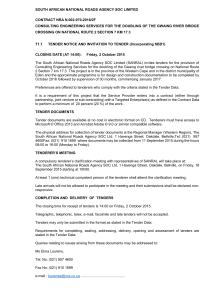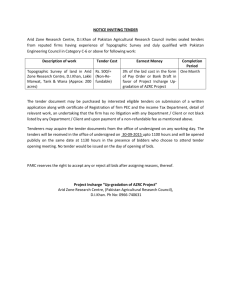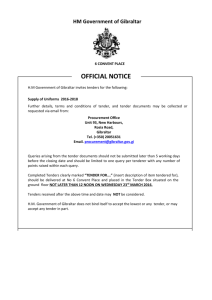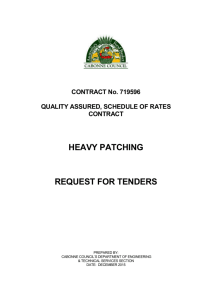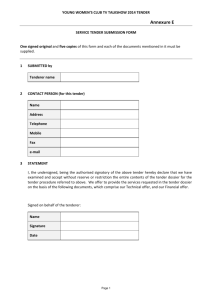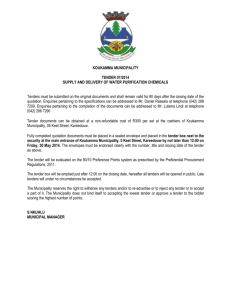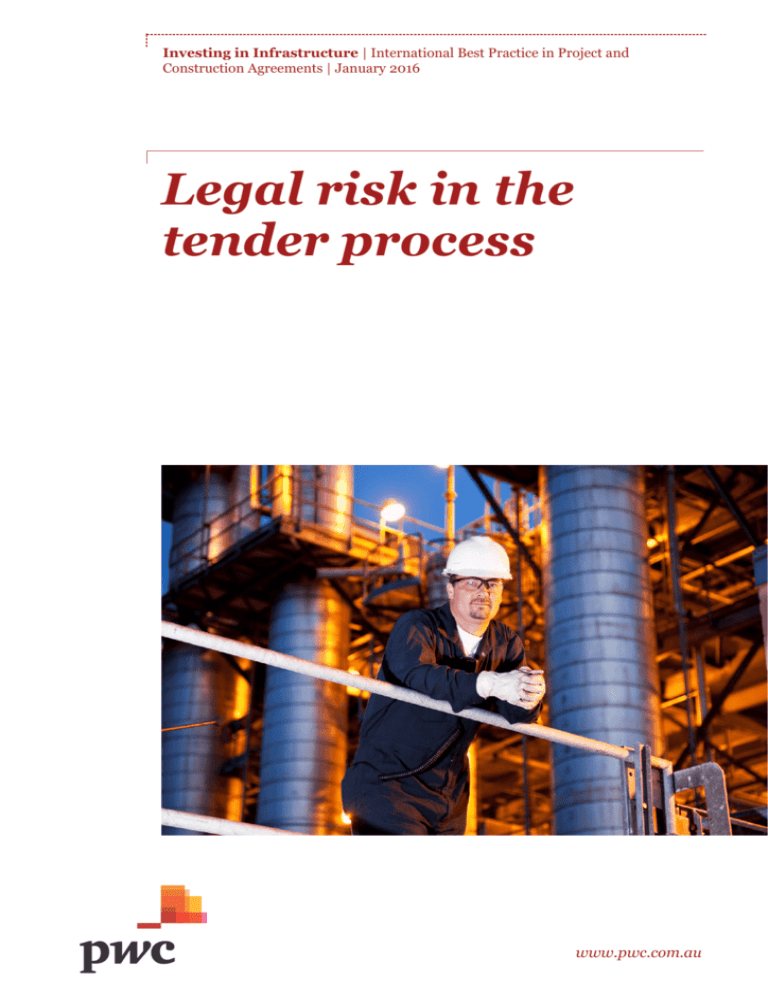
Investing in Infrastructure | International Best Practice in Project and
Construction Agreements | January 2016
Legal risk in the
tender process
www.pwc.com.au
Legal risk in the tender process
Introduction
This Update is intended to highlight some of the potential risks associated with the drafting of a request for
tender (RFT) and the conduct of a tender process and to provide suggestions as to how those risks may be
minimised.
Contractual analysis of the tender process
When inviting tenders, a party may inadvertently create legal obligations. That party may rely too heavily on the
traditional contractual analysis of the tendering process, unaware that obligations to tenderers have been
created. The traditional contractual analysis of the tendering process is that:
• the issue of a RFT by the party inviting tenders is no more than an invitation to treat, not an offer
• the submission of a tender in response to the RFT by a tenderer amounts to an offer by that tenderer
• no binding contract arises between the parties until a tender is accepted by the party inviting tenders.
If this traditional contractual analysis was applied strictly to the period up until a contract is awarded to a
tenderer (the “pre-award period”), there would be no binding legal relationship between a party inviting
tenders and a tendering party during the pre-award period. However, in certain circumstances, courts have
been willing to impose binding legal relationships between the party inviting tenders and a tenderer during the
pre-award period.
A binding legal relationship may arise during the pre-award period as a result of:
• process contracts: A contract arising in relation to the tender process before acceptance of a tender by the
party inviting tenders
• negligence: There may be circumstances in which the party inviting tenders owes a duty of care to a tenderer
• estoppel: Which may arise from the conduct of, and/or representations made by, the party inviting tenders
during the pre-award period
• statute: For example, in Australia remedies under the Competition and Consumer Act 2010 may be available
in relation to conduct of the party inviting tenders during the pre-award period. Under the Act, a person
participating in trade or commerce must not engage in conduct that is, or is likely to be, misleading or
deceptive. 1 If a party inviting tenders does not honour its representation that tender evaluation criteria will
be complied with, it could be in breach of this requirement.
Process contracts
The courts of Australia, New Zealand, Canada and England have been increasingly willing to find that a process
contract exists, binding the party inviting tenders to conduct the tender process during the pre-award period in
a particular manner.
If a binding process contract exists, an unsuccessful tenderer may be entitled to any loss resulting from a breach
of that process contract by the party inviting tenders. As such, a party issuing a RFT should carefully consider
whether it intends that the tender process to form a binding legal relationship.
1
Competition and Consumer Act 2010 (Cth), sch 2, s18.
PwC
3
Legal risk in the tender process
Risk management strategies
There are various alternative courses of action that a party inviting tenders may adopt, in respect of its
tendering process, in order to manage the legal risks discussed above.
Binding process contract
A party inviting tenders may enter into an express contract with each tenderer in respect of the pre-award
period. This would provide a level of certainty regarding the legal relationship between the party inviting
tenders and each tenderer during the pre-award period by expressly stating the terms and conditions governing
their relationship.
However, this approach would be impractical if each process contract had to be negotiated with each tenderer.
Also, it could potentially increase the party inviting tenders’ exposure to liability in the sense that there would
be the potential for such process contracts to be breached in circumstances where a contractual relationship
would not have otherwise been found, by a court, to exist.
In Australia, there have been a number of decisions that have determined that a process contract has existed
between the Commonwealth and tenderers.
In Hughes Aircraft Systems International v Airservice Australia, 2 a process contract was found to arise out of
a public tender for an air traffic system acquisition contract. The court implied terms of fair process and fair
dealing.
This analysis was adopted in Cubic Transportation Systems Inc v NSW, 3 where the court found that a process
contract arose out of a tender and read down a clause in the conditions of tender purporting to exclude a
process contract. On those facts, no breach of an implied term was found.
In IPEX ITG Pty Ltd (in liq) v State of Victoria, 4 the court found that a process contract arose for a request for
tender for system integration services. The court found that tender documents will determine if parties intend
to be bound by a process contract. A process contract arose in this case because detailed process criteria
timelines, which suggested promissory obligations, were used.
Parties inviting tenders should be aware that detailed processes in requests for tenders are more likely to give
rise to process contracts.
Non-binding
Assuming that a party inviting tenders does not want to enter into an express process contract, that party must
clearly delineate rights and liabilities in the RFT in order to address the uncertainties associated with the
potential finding of a binding contractual relationship. Accordingly, the RFT should expressly exclude any
intention for a binding contractual relationship between the parties to be formed during the pre-award period
or, at least, limit the extent of any binding legal relationship. Suitable wording to make clear that the party
inviting tenders has adequate time to review the tenders, but that no further legal relationship is intended to be
formed, would be:
No binding legal relationship will exist between any tenderer and the Principal until the successful tenderer
and the Principal execute the Contract…
Flexibility for party inviting tenders – What a RFT should allow for
Whether a party inviting tenders decides to create an expressly binding process contract or not, various waivers
and conditions of tender should be included in an RFT, so that they form part of any process contract which the
2
(1997) 146 ALR 1.
3
[2002] NSWSC 656
4
[2010] VSC 480.
PwC
4
Legal risk in the tender process
party inviting tenders intends entering or which is otherwise held to have been formed. These conditions
primarily relate to:
• the ability of the party inviting tenders to accept non-conforming tenders
• the ability of the party inviting tenders to accept late tenders
• the ability of the party inviting tenders not to accept the lowest priced tender
• the ability of the party inviting tenders to vary the tender process
• any limitation of liability and exclusion of remedies, to the extent possible under law.
Form of tender
It is important that verification and sign-off procedures are implemented for RFTs issued by a party inviting
tenders in order to minimise the risks associated with the possibility:
• that the RFT incorporates any misleading or deceptive statements
• of any negligent misstatements being held to have been made.
The party inviting tenders should include a disclaimer in the RFT requiring the tenderer to fully inform
themselves of all matters relating to the tendered project. The following may be suitable:
The Tender Documents do not purport to contain all relevant information in relation to the Contractor's
activities or the works, and are provided solely on the basis that a Tenderer will be responsible for making its
own assessment of the matters referred to in the Tender Documents.
The Principal advises the Tenderer and the Tenderer agrees to verify all relevant representations, statements
and information (including those contained or referred to in the Tender Documents or made orally during the
course of any discussions with the Principal, its employees or agents). No person has been authorised to make
any representation or warranty in connection with the Tender Documents and any such representation or
warranty, if given or made, should not be relied on as having been authorised by the Principal.
The Tenderer is responsible for reviewing the Tender Documents (including all addenda) provided by or on
behalf of the Principal to ensure that it has a complete copy of all documents.
The Principal and its directors, employees and agents do not make any representation or warranty (express
or implied) as to the accuracy or completeness of the information provided to a Tenderer.
The suitability of this disclaimer should be considered in the circumstances of each project. In addition to the
disclaimer, the Principal should require the tenderer to warrant in the form of tender that it has not relied on
the information provided in the request for tender, and has independently assessed such information. The
following may be suitable:
We warrant that we have not relied on information provided, or represented to be provided, by or on behalf
of the Principal without independently verifying that information and independently satisfying ourselves of
the adequacy, accuracy and correctness of the information.
Training
It may be desirable for the staff who are commonly involved in conducting the tender processes to undertake
specific training to highlight the legal risks associated with tender processes. In particular, that training should
focus on:
• the need to take care in dealing with tenderers to minimise the risk of liability arising through
representations made to tenderers
PwC
5
Legal risk in the tender process
• documentation requirements, including both the RFT and documentation provided during the pre-award
period.
Conclusion
There are many risks associated with the drafting of RFTs and with the tender process. It should not be
assumed that, prior to the execution of a project contract, no binding legal relationship exists. Obligations and
liabilities can arise from a RFT. However, with careful drafting, the existence or scope of such obligations and
potential liabilities can be minimised.
PwC
6
www.pwc.com.au
© 2016 PricewaterhouseCoopers. All rights reserved.
PwC refers to the Australian member firm, and may sometimes refer to the PwC network.
Each member firm is a separate legal entity. Please see www.pwc.com/structure for further details.
At PwC Australia our purpose is to build trust in society and solve important problems. We’re a
network of firms in 157 countries with more than 208,000 people who are committed to delivering
quality in assurance, advisory and tax services. Find out more and tell us what matters to you by
visiting us at www.pwc.com.au
Liability limited by a scheme approved under Professional Standards Legislation.

